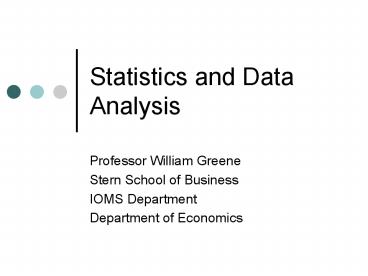Statistics and Data Analysis - PowerPoint PPT Presentation
1 / 6
Title:
Statistics and Data Analysis
Description:
The winner is the team with the highest total of the scores for the two halves. ... For any first half margin, say M, since they are evenly matched, there is a 50 ... – PowerPoint PPT presentation
Number of Views:50
Avg rating:3.0/5.0
Title: Statistics and Data Analysis
1
Statistics and Data Analysis
- Professor William Greene
- Stern School of Business
- IOMS Department
- Department of Economics
2
Statistics and Data Analysis
Part 3a Interesting Probability Puzzles
3
2 Classic Problems and 1 Intriguing One
33/36
- The birthday problem
- The Monty Hall problem
- Halftime winner
4
The Birthday Problem
34/36
- What is the probability that everyone in this
room has a different birthday? (50 people)
5
The Monty Hall Problem
35/36
Suppose you're on a game show, and you're given
the choice of three doors Behind one door is a
car behind the others, goats. You pick a door,
say No. 1, and the host, who knows what's behind
the doors, opens another door, say No. 3, which
has a goat. He then says to you, "Do you want to
pick door No. 2?" Is it to your advantage to
switch your choice?
Answer It definitely pays to switch. See
Notes for this class or browse the 1,000,000
plus hits youll find if you search for this
problem on the web.
6
Throwing in the Towel
36/36
Consider a sporting event with two halves.
Scores accumulate in each half. The winner is
the team with the highest total of the scores for
the two halves. (Baseball, Hockey, Football,
Basketball, Rugby) No ties (so this doesnt work
well for soccer). The two teams are evenly
matched, and they play exactly as hard in the
second half as in the first. Given that a team
is ahead at the halftime, what is the probability
that they will win the game? Intuition
(incorrectly) says .5. (If team A wins the first
half, its as likely that team B will win the
second half.) The correct answer is .75! The
simple intuition is that it is not sufficient for
team B to win in the second half. Team B must
win by a higher margin in the second half than
team A had in the first half. Since they are
evenly matched, that probably is only .25.
Formally, there is a 50 chance that team A will
win the second half outright. For any first half
margin, say M, since they are evenly matched,
there is a 50 chance that each team will exceed
that margin, so A wins the game in half of the
cases that B wins the second half and all of the
cases when A wins the second half.
See Jeffrey Simonoff, Probability the language
of randomness, pp. 10-12.































